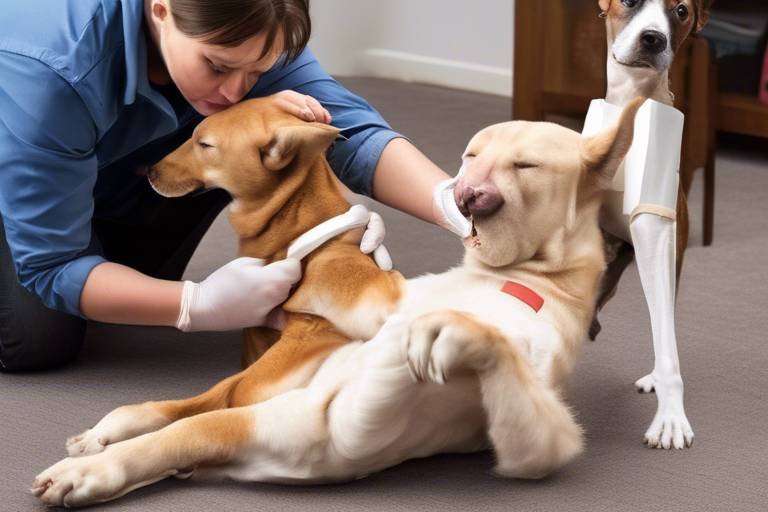How to Recognize and Manage Pet Stress
In our fast-paced world, we often forget that our furry friends can experience stress just like we do. Understanding how to recognize and manage pet stress is essential for fostering a healthy and happy environment for our beloved companions. Just like humans, pets can feel overwhelmed, anxious, and even depressed, which can lead to serious health issues if left unaddressed. So, how can we ensure our pets are living their best lives? Let’s dive into the signs of stress in pets and explore effective management strategies that can help them feel secure and relaxed.
Recognizing the causes and symptoms of pet stress is vital for any pet owner. Just think of it this way: if you were in a crowded room with loud noises and unfamiliar faces, wouldn’t you feel a bit anxious? Pets can experience similar feelings. Common triggers include changes in their environment, loud noises (like thunderstorms), unfamiliar visitors, and even changes in routine. By understanding these stressors, we can take proactive steps to mitigate their impact on our pets’ mental health.
Identifying stress in pets can be challenging, especially since they can’t verbally communicate their feelings. However, being observant can make a world of difference. Here are some key behavioral and physical signs that indicate your pet may be feeling stressed:
Pets often exhibit specific behaviors when stressed. You might notice your furry friend becoming more aggressive, withdrawn, or excessively vocal. For instance, if your dog suddenly starts barking at every little sound or if your cat hides away for hours, these could be signs of stress. It’s essential to pay attention to these changes, as they often indicate that something is bothering your pet.
A stressed pet may alter its eating patterns significantly. Some pets may overeat as a coping mechanism, while others might lose their appetite altogether. If you notice your pet is leaving food untouched or, conversely, gobbling it down too quickly, it’s time to investigate further. Stress can lead to serious health issues, so monitoring their eating habits is crucial for their well-being.
Physical signs of stress can manifest in various ways. For example, excessive grooming, trembling, or hiding are common indicators that your pet may be feeling anxious. Just like how we might bite our nails or fidget when nervous, pets have their own ways of expressing discomfort. If you observe your pet engaging in these behaviors frequently, it might be time to assess their environment and lifestyle.
Understanding the environment's role in your pet's stress levels is crucial. Various factors can contribute to anxiety in pets, including:
- Noise levels (e.g., fireworks, thunder)
- Changes in household dynamics (e.g., new family members, moving)
- Inconsistent routines (e.g., feeding times, walks)
By identifying these environmental stressors, you can take steps to create a more peaceful home for your pet.
Effective management strategies can significantly reduce pet stress. The goal is to create a safe and calming environment that allows your pet to thrive. Here are some techniques to help your pet feel more secure and relaxed:
Establishing a safe and comfortable area for your pet can alleviate stress. Think of it as their personal sanctuary. This could be a cozy corner with their favorite blanket, a quiet room away from the hustle and bustle, or even a designated crate where they can retreat when feeling overwhelmed. Make sure this space is filled with familiar scents and items that make them feel at home.
Training plays a vital role in managing pet stress. Positive reinforcement techniques can help your pet cope with anxiety-inducing situations. For example, if your dog is afraid of loud noises, gradual desensitization to those sounds can help them build confidence. Additionally, teaching commands and tricks can provide mental stimulation and strengthen your bond with your pet, ultimately reducing their anxiety.
1. How can I tell if my pet is stressed?
Look for changes in behavior, eating habits, and physical symptoms like excessive grooming or hiding. Being observant is key!
2. What are some common stressors for pets?
Common stressors include loud noises, changes in the household, and inconsistent routines.
3. How can I create a safe space for my pet?
Designate a quiet area with comfortable bedding and familiar items where your pet can retreat when they feel anxious.
4. Can training help reduce my pet's stress?
Absolutely! Positive reinforcement training can help your pet build confidence and cope with anxiety-inducing situations.

Understanding Pet Stress
Recognizing the causes and symptoms of pet stress is vital for every pet owner. Just like humans, our furry friends can experience stress, and it can have a profound effect on their overall well-being. Imagine a dog that used to wag its tail excitedly every time you came home, but now it just sits in the corner, looking anxious. This change can be alarming, and understanding the underlying reasons is the first step in helping your pet.
Stress in pets can stem from a variety of sources. Common triggers include changes in the environment, such as moving to a new home, the introduction of a new pet, or even loud noises from nearby construction. Additionally, separation anxiety is a significant concern for many pets, especially those that are particularly attached to their owners. Understanding these stressors is crucial because it allows you to create a more supportive environment for your beloved companions.
Moreover, it's essential to note that the signs of stress can vary significantly between different species and even individual pets. For instance, while a cat may respond to stress by hiding under the bed, a dog might bark excessively or become aggressive. This variability can make it challenging to pinpoint the exact cause of your pet's distress. However, being observant and aware of these differences can help you take proactive measures to mitigate their stress.
In many cases, stress can also be linked to physical health issues. For example, a pet that is in pain or discomfort may exhibit signs of stress that can be mistaken for behavioral problems. Therefore, if you notice any sudden changes in behavior, it’s always a good idea to consult with your veterinarian to rule out any underlying health issues.
Ultimately, understanding pet stress is not just about recognizing the signs; it’s also about fostering a healthy and happy environment for our furry companions. By being attentive to their needs and creating a stable atmosphere, we can help alleviate their anxiety and promote their overall well-being. Remember, your pet relies on you to be their advocate, and understanding their stress is a crucial part of that responsibility.
- What are common signs of stress in pets? Look for changes in behavior, eating habits, and physical symptoms like excessive grooming or trembling.
- How can I help my pet manage stress? Create a safe space, provide consistent routines, and consider behavioral training techniques.
- Is stress in pets a serious issue? Yes, chronic stress can lead to health problems, so it’s important to address it promptly.

Signs of Stress in Pets
Identifying stress in pets can be quite a challenge, especially since our furry friends can't simply tell us what's bothering them. Just like humans, pets express their feelings through various behaviors and physical signs. Being observant is key to understanding their emotional state. When you notice changes in your pet's behavior, it’s crucial to take a closer look and figure out what might be causing their discomfort. After all, a happy pet means a happy home!
One of the first things to consider is behavioral indicators. Pets often exhibit specific behaviors when stressed. For instance, you might notice your dog becoming more aggressive or your cat withdrawing from social interactions. Excessive barking or meowing can also signal anxiety. These changes in behavior can be alarming, but they serve as important signals that something isn't quite right in your pet's world.
Let’s dive deeper into some common behavioral changes that may indicate stress:
- Aggression: If your normally friendly pet suddenly snaps or growls, it may be feeling threatened or anxious.
- Withdrawal: A stressed pet might isolate itself, hiding under furniture or in a quiet corner.
- Excessive Vocalization: Increased barking or meowing can be a cry for help, signaling that your pet is feeling overwhelmed.
Another significant sign of stress can be found in your pet's eating habits. When stress takes hold, pets often alter their eating patterns. Some may overeat as a coping mechanism, while others may lose their appetite altogether. This change can lead to health issues, so it’s essential to keep an eye on their food intake. If you notice your pet is eating less or more than usual, it’s worth investigating further.
To put it simply, a stressed pet may display one of the following eating behaviors:
- Overeating: If your pet seems to be gobbling up food like it’s going out of style, it could be a response to stress.
- Loss of Appetite: Conversely, if your pet is ignoring its food bowl, it may be feeling anxious or unwell.
Physical symptoms are another area to monitor. Just as with humans, stress can manifest in physical ways in pets. You might notice your dog or cat engaging in excessive grooming, which can lead to bald patches or skin irritations. Additionally, trembling or shaking can indicate that your pet is feeling anxious. Hiding is also a common response; if your pet is frequently seeking out dark, secluded spots, it’s a clear sign that they’re not feeling secure.
Here are some physical signs you should be on the lookout for:
- Excessive Grooming: Over-grooming can lead to skin problems and is often a sign of stress.
- Trembling: Shaking can indicate fear or anxiety, especially during loud noises like thunderstorms.
- Hiding: If your pet is suddenly spending more time in their hiding spots, it may be feeling overwhelmed.
Finally, let’s talk about environmental stressors. The environment plays a significant role in your pet's stress levels. Factors such as loud noises, changes in routine, or the introduction of new pets can create a sense of anxiety. Understanding these triggers can help you create a more harmonious living space for your beloved companion.
In conclusion, recognizing the signs of stress in pets is not just about observing their behavior; it’s about understanding their emotional needs. By being attentive to these signs, you can take proactive steps to alleviate their stress and foster a happier, healthier environment for them.
Q: How can I tell if my pet is stressed?
A: Look for behavioral changes such as aggression, withdrawal, excessive vocalization, and changes in eating habits. Physical signs like excessive grooming, trembling, or hiding can also indicate stress.
Q: What should I do if I notice my pet is stressed?
A: First, identify the potential triggers in their environment. Then, consider creating a safe space for them and consult with a veterinarian if the stress persists.
Q: Can stress in pets lead to health issues?
A: Yes, prolonged stress can lead to various health problems, including obesity, gastrointestinal issues, and behavioral disorders.
Behavioral Indicators
When it comes to our furry friends, understanding their emotions is just as important as recognizing their physical health. can provide crucial insights into whether your pet is feeling stressed. Just like humans, pets communicate their feelings through their actions, and being attuned to these signs can help you address their needs promptly. So, what should you be looking for?
One of the most common signs of stress in pets is aggression. If your usually friendly dog suddenly starts barking at strangers or your cat swats at you when you try to pet them, it might be a cry for help. It’s as if they’re saying, “I’m overwhelmed! Give me some space!” On the flip side, some pets may become withdrawn when stressed. You might notice your dog hiding under the bed or your cat spending excessive time in their favorite hiding spot. This behavior signals that they are trying to cope with their anxiety by retreating to a safe space.
Another behavioral change to watch for is excessive vocalization. If your pet is barking or meowing more than usual, it could be their way of expressing discomfort. Just think of it as their version of shouting, “Help! I’m not okay!” In contrast, a sudden silence from your usually chatty pet can also be alarming. This quietude could indicate that they are feeling stressed and overwhelmed, leading them to withdraw from interaction.
It’s essential to consider the context of these behaviors. For instance, if your dog is barking at every little noise, it might be a response to a new environment or changes in routine. Similarly, a cat that suddenly becomes aggressive might be feeling threatened by a new pet or unfamiliar visitors. Understanding the triggers behind these behaviors can help you address the root cause of the stress.
In addition to aggression and withdrawal, you might notice changes in your pet's playfulness. A once-enthusiastic dog that no longer wants to fetch the ball or a cat that ignores their favorite toy may be showing signs of stress. This shift can be alarming, as play is a vital part of a pet's well-being. If you notice these changes, take a moment to evaluate their environment and daily routine.
Ultimately, recognizing these behavioral indicators is the first step in helping your pet feel more secure. By being observant and responsive to their needs, you can create a nurturing environment that minimizes stress. Remember, your pet relies on you to interpret their signals and provide the comfort they crave.
- What should I do if I notice signs of stress in my pet? It's essential to assess their environment and routine. Consider consulting a veterinarian or a pet behaviorist for tailored advice.
- Can stress in pets lead to health problems? Yes, prolonged stress can lead to various health issues, including digestive problems, weakened immune systems, and behavioral issues.
- How can I help my pet relax? Creating a safe space, maintaining a consistent routine, and engaging in calming activities such as gentle play or petting can help alleviate stress.
Changes in Eating Habits
When it comes to our furry friends, can be one of the most telling signs of stress. Just like us, pets can experience a range of emotions that affect their appetite. They might suddenly refuse to eat their favorite treats or, conversely, they may start gobbling down their food as if it were their last meal. This shift can be alarming for any pet owner, and understanding the reasons behind these changes is crucial for maintaining your pet's health.
One of the primary reasons pets may lose their appetite is due to stressors in their environment. New noises, unfamiliar visitors, or even changes in routine can make them feel uneasy. For instance, if you’ve recently moved to a new home or brought a new pet into the family, your furry companion might be feeling a bit overwhelmed. On the other hand, some pets might react to stress by overeating, using food as a comfort mechanism. It's a bit like how we might reach for ice cream after a tough day!
Here are some common ways that stress can manifest in your pet's eating habits:
- Loss of Appetite: If your pet is turning its nose up at food, it could indicate anxiety or discomfort. This is especially concerning if the refusal lasts more than a day.
- Increased Appetite: Some pets may eat excessively when stressed, which can lead to obesity and other health issues if not managed properly.
- Changes in Food Preferences: A stressed pet may suddenly prefer one type of food over another, or they may become picky eaters.
It’s essential to monitor your pet's eating habits closely. If you notice any significant changes, consider keeping a food diary to track their meals and any associated behaviors. This can help you identify patterns and triggers that might be causing their stress. Additionally, consulting with a veterinarian can provide insights into whether the changes are purely behavioral or if there are underlying health issues at play.
Ultimately, ensuring your pet has a consistent feeding schedule and a calm eating environment can help mitigate stress-related eating issues. Just like we appreciate a peaceful meal, our pets thrive in a stress-free setting where they can enjoy their food without distractions. So, if you notice your pet acting differently around mealtime, take a moment to assess their surroundings and provide them with the comfort they need.
Q: How can I tell if my pet is stressed?
A: Look for behavioral changes such as aggression, withdrawal, or changes in eating and sleeping habits. Physical signs may include excessive grooming, trembling, or hiding.
Q: What should I do if my pet stops eating?
A: If your pet refuses to eat for more than a day, consult your veterinarian to rule out any health issues. Meanwhile, try to create a calm environment and ensure they feel safe.
Q: Can stress in pets lead to health problems?
A: Yes, prolonged stress can lead to a range of health issues, including digestive problems, obesity, and weakened immune systems. It's essential to manage your pet's stress effectively.
Q: What are some effective ways to reduce my pet's stress?
A: Creating a safe space, maintaining a consistent routine, and engaging in calming activities like gentle play or relaxation techniques can help reduce your pet's stress levels.
Physical Symptoms
When it comes to our beloved pets, their well-being is often reflected in their physical condition. Just like us, pets can experience stress, and this emotional turmoil can manifest in various physical symptoms that are crucial for pet owners to recognize. For instance, you might notice that your furry friend is excessively grooming themselves. While grooming is a natural behavior, if it escalates to the point where they're creating bald patches or skin irritations, it's a clear sign that something is amiss. Think of it like a person biting their nails when anxious; it’s a coping mechanism that can lead to further issues.
Another common physical symptom is trembling. If your pet suddenly starts shaking, even in familiar surroundings, it could indicate stress or fear. Imagine feeling nervous before a big presentation; that jittery feeling can be just as intense for your pet. Additionally, some pets may resort to hiding more frequently, seeking refuge in tight spaces or under furniture. This instinctive behavior is their way of trying to escape from what they perceive as threats in their environment.
Moreover, changes in breathing patterns can also be a telltale sign of stress. Rapid, shallow breaths or panting, even when they haven't been active, can indicate that your pet is feeling overwhelmed. It's essential to observe these changes closely, as they can lead to more severe health issues if not addressed. To help you identify these symptoms better, here’s a quick overview of some physical signs of stress in pets:
| Physical Symptom | Description |
|---|---|
| Excessive Grooming | Over-grooming can lead to bald spots or skin infections. |
| Trembling | Shaking or shivering, often in a calm environment. |
| Hiding | Seeking out tight spaces to feel secure. |
| Changes in Breathing | Rapid or shallow breathing without physical exertion. |
Understanding these physical symptoms is essential for any pet owner. By being vigilant and observant, you can create a supportive environment that helps your furry friend feel safe and secure. Remember, just like a friend who needs a listening ear during tough times, our pets also require our attention and care when they are under stress. If you notice any of these symptoms persisting, it’s always a good idea to consult your veterinarian for advice tailored to your pet's specific needs.
- What should I do if I notice my pet showing signs of stress? It's important to assess the situation and identify potential triggers. Creating a calm environment and consulting a veterinarian can help.
- Can stress lead to serious health issues in pets? Yes, prolonged stress can lead to various health problems, including behavioral issues and physical ailments.
- How can I tell if my pet is stressed or just being lazy? Look for changes in behavior, eating habits, and physical symptoms. Stress often comes with a range of signs that differ from normal laziness.
Environmental Stressors
Understanding the environment's role in your pet's stress levels is crucial. Just like humans, pets are significantly affected by their surroundings. Imagine living in a noisy, chaotic space where you can't find a moment of peace; that’s how your furry friend might feel in a stressful environment. Common environmental stressors can range from loud noises to changes in routine, and recognizing these triggers is the first step in helping your pet feel more at ease.
One of the most significant environmental stressors is noise. Loud sounds, such as thunderstorms, fireworks, or even the vacuum cleaner, can send your pet into a tailspin of anxiety. Pets have sensitive hearing, and what may seem like a minor disturbance to us can be overwhelming for them. Furthermore, sudden changes in their environment, like moving to a new home or the introduction of a new family member (human or pet), can create feelings of insecurity and stress.
Another factor to consider is the presence of other animals. Pets that are not properly socialized may feel threatened or anxious when around unfamiliar animals, leading to stress responses. This is particularly true for dogs and cats that have had negative experiences in the past. Additionally, the layout of your home can contribute to stress. For instance, if your pet lacks a quiet place to retreat, they may become easily overwhelmed by daily activities.
To help mitigate these environmental stressors, consider the following tips:
- **Create a quiet zone:** Designate a specific area in your home where your pet can retreat to feel safe and secure. This space should be away from the hustle and bustle of daily life.
- **Manage noise levels:** Use white noise machines or calming music to help drown out sudden loud sounds that can trigger anxiety.
- **Maintain a routine:** Pets thrive on stability. Keeping a consistent schedule for feeding, walks, and playtime can help reduce anxiety.
By being mindful of these environmental stressors and taking proactive steps to address them, you can create a more peaceful atmosphere for your pet. Remember, a relaxed pet is a happy pet!
Q: What are some common signs that my pet is stressed?
A: Common signs include excessive barking or meowing, changes in eating habits, excessive grooming, and hiding. If you notice any of these behaviors, it may be time to evaluate their environment.
Q: How can I help my pet feel more secure during stressful situations?
A: Creating a safe space, using calming products like pheromone diffusers, and maintaining a consistent routine can help your pet feel more secure.
Q: Can environmental stressors affect my pet's health?
A: Yes, chronic stress can lead to various health issues in pets, including digestive problems, weakened immune systems, and behavioral issues. Addressing stress is essential for their overall well-being.

Managing Pet Stress
Managing pet stress is not just about alleviating discomfort; it's about creating a harmonious relationship between you and your furry friend. Just like humans, pets can experience stress, and as their guardians, it's our responsibility to recognize and address their needs. The good news is that there are effective strategies to help your pet feel more secure and relaxed. Think of it as building a cozy sanctuary for your pet where they can unwind and feel safe. After all, a happy pet means a happy home!
One of the most effective ways to manage pet stress is by creating a safe space. This is a designated area in your home where your pet can retreat when they feel overwhelmed. It could be a cozy corner with their favorite blanket, a quiet room away from the hustle and bustle, or even a crate that they associate with comfort. To make this space inviting, consider adding some familiar toys, a comfy bed, and perhaps a piece of your clothing to provide a sense of security. Remember, this should be a place where they can escape the chaos of daily life, much like how we all need a little 'me time' every now and then.
Another crucial aspect of managing pet stress is through behavioral training techniques. Training isn't just about teaching your pet commands; it's also about helping them develop coping mechanisms for stressful situations. For instance, if your pet tends to get anxious during thunderstorms, you could gradually desensitize them to the sound of thunder by playing recordings at a low volume while rewarding them with treats for calm behavior. This method not only helps them associate the sound with positive experiences but also builds their confidence. Consistency is key here, as it helps reinforce the behavior you want to see.
Additionally, consider incorporating regular exercise into your pet's routine. Exercise is a fantastic way to reduce stress and anxiety in pets. A simple game of fetch or a brisk walk not only helps release pent-up energy but also strengthens the bond between you and your pet. Think of it as a two-for-one deal: you get to enjoy some quality time together while keeping your pet physically and mentally stimulated.
Moreover, don’t underestimate the power of environmental enrichment. This involves providing your pet with engaging activities and toys that stimulate their mind. Puzzle toys, interactive games, and even scent work can keep your pet entertained and mentally sharp. By keeping their minds occupied, you can help reduce the likelihood of stress-related behaviors. Just like us, pets thrive when they have something to focus on, so think of enrichment as a way to keep their brains busy and their spirits high!
Lastly, it's important to monitor your pet's health and well-being. Sometimes stress can be a symptom of underlying health issues. Regular veterinary check-ups can help catch any potential problems early and ensure your pet is in tip-top shape. If you notice persistent signs of stress despite your best efforts, consulting a professional trainer or a veterinarian can provide tailored strategies to help your pet cope.
In conclusion, managing pet stress is all about understanding your pet's unique needs and creating an environment that fosters comfort and security. By implementing these strategies, you'll not only help reduce their stress but also enhance your relationship with them. Remember, a relaxed pet is a happy pet, and that happiness radiates throughout your home!
Q: What are the common signs of stress in pets?
A: Common signs include excessive grooming, changes in eating habits, aggression, withdrawal, and vocalization changes like excessive barking or meowing.
Q: How can I tell if my pet is stressed during a thunderstorm?
A: Look for signs such as trembling, hiding, or seeking comfort from you. If your pet seems unusually anxious, they may be stressed.
Q: Is it normal for pets to experience stress?
A: Yes, pets can experience stress just like humans. It's important to recognize the signs and take steps to help them feel more comfortable.
Q: Can stress lead to health issues in pets?
A: Absolutely. Chronic stress can lead to various health problems, including digestive issues, weakened immune response, and behavioral problems.
Q: When should I consult a veterinarian regarding my pet's stress?
A: If your pet shows persistent signs of stress despite your interventions, or if their behavior changes dramatically, it's best to consult a veterinarian for professional advice.
Creating a Safe Space
Creating a safe space for your pet is essential in helping them feel secure and relaxed. Just like we all have our favorite nooks and crannies where we can unwind after a long day, pets also need their own special spot to retreat to when they feel overwhelmed. Imagine your pet being able to escape to a cozy haven where they can curl up, away from the hustle and bustle of daily life. This sanctuary can significantly reduce their stress levels and improve their overall well-being.
When designing this safe space, consider the following elements:
- Location: Choose a quiet area of your home that is away from loud noises, such as the television or busy streets. A corner of a room or a cozy nook can work wonders.
- Comfort: Fill the space with soft bedding, blankets, and perhaps a favorite toy. Just like a comfy chair can be inviting for us, a plush bed can be a magnet for your pet.
- Accessibility: Ensure that your pet can easily access their safe space whenever they need it. If you have a dog, consider placing their bed in a spot where they can see you but still feel secure.
- Personalization: Add items that your pet loves, whether it’s a favorite blanket or a piece of your clothing. Familiar scents can have a calming effect on pets, creating a sense of security.
It's also important to teach your pet that this space is a safe retreat. Encourage them to use it by offering treats or praise when they go there. Over time, they will associate the area with positive experiences, making it their go-to spot during stressful moments. You might even notice them seeking out this space during thunderstorms or when there are unfamiliar visitors in the house.
In addition to a physical space, consider the emotional aspect of safety. Regularly spending quality time with your pet can help build their confidence and mitigate anxiety. Engaging in activities like gentle play or simply cuddling can reinforce their sense of security, making them feel loved and protected.
Lastly, remember that every pet is unique. What works for one may not work for another. Observing your pet's behavior and preferences is key to creating the perfect safe haven for them. With a little patience and creativity, you can craft a sanctuary that not only eases their stress but also strengthens the bond you share.
Q: How can I tell if my pet is using their safe space effectively?
A: If you notice your pet frequently retreating to their safe space during stressful situations, it’s a good sign they find it comforting. Additionally, if they relax or sleep in that area, it indicates they feel secure there.
Q: Can I create a safe space for multiple pets?
A: Absolutely! While each pet may need their own designated area, you can create a shared space that includes separate beds or cozy spots. Just make sure each pet has access to their own safe retreat when needed.
Q: What if my pet refuses to use the safe space?
A: If your pet is hesitant, try enticing them with treats, toys, or even your presence. Be patient and give them time to adjust. Sometimes, it takes a little while for them to feel comfortable in a new environment.
Behavioral Training Techniques
When it comes to managing pet stress, can be a game changer. Think of training as a bridge that connects your pet's instincts with your expectations. By teaching your furry friend how to cope with anxiety-inducing situations, you not only help them feel more secure but also strengthen your bond. Just like humans, pets can benefit from a structured approach to handling stress.
One effective method is the use of positive reinforcement. This technique involves rewarding your pet for desirable behaviors, which encourages them to repeat those behaviors in the future. For instance, if your dog is nervous around strangers, you can train them to sit and stay when someone approaches. Each time they successfully remain calm, offer them a treat or praise. Over time, your pet will associate the presence of strangers with positive experiences, reducing their anxiety.
Another valuable approach is desensitization. This technique gradually exposes your pet to the stressor in a controlled manner. For example, if your cat is scared of loud noises, you might start by playing recordings of those sounds at a low volume. Gradually increase the volume as your pet becomes more comfortable. The goal is to help them understand that these noises are not harmful. It’s like slowly introducing a child to the deep end of a swimming pool—start shallow and work your way up!
Additionally, implementing consistent routines can provide a sense of stability for your pet. Animals thrive on predictability, and having a structured daily schedule can significantly reduce their stress levels. For instance, try to feed, walk, and play with your pet at the same times each day. This routine not only helps your pet feel more secure but also allows you to monitor any changes in their behavior more effectively.
Finally, consider incorporating mindfulness techniques into your training. Just like yoga can calm a human mind, certain activities can help soothe your pet. For example, engaging in gentle play sessions or using calming music can create a relaxing atmosphere. You might be surprised at how a simple change in your environment can help your pet unwind.
In conclusion, behavioral training techniques are essential tools in your toolkit for managing pet stress. By using positive reinforcement, desensitization, maintaining consistent routines, and incorporating mindfulness, you can help your furry friend navigate their world with confidence. Remember, the goal is not just to train your pet but to create a safe and loving environment where they can thrive.
- What are the common signs of stress in pets? Pets may exhibit signs like excessive grooming, aggression, withdrawal, or changes in eating habits.
- How can I tell if my pet is anxious? Look for behaviors such as pacing, whining, or hiding. These can indicate that your pet is feeling anxious.
- Is it possible to completely eliminate stress in pets? While you may not eliminate all stress, you can certainly manage and reduce it through training and environmental adjustments.
- What role does environment play in pet stress? A chaotic or unfamiliar environment can significantly contribute to anxiety in pets. Creating a calm space can help alleviate this.
Frequently Asked Questions
- What are the common signs of stress in pets?
Pets can show stress through various signs, including behavioral changes like aggression or withdrawal, changes in eating habits, and physical symptoms such as excessive grooming or trembling. Keeping an eye on these indicators can help you respond to your pet's needs swiftly.
- How can I create a safe space for my pet?
To create a safe space for your pet, choose a quiet area in your home where they can retreat when feeling stressed. Add their favorite blanket or bed, toys, and ensure the area is free from loud noises or disturbances. This will help your furry friend feel more secure and relaxed.
- What environmental factors can cause stress in pets?
Common environmental stressors include loud noises, changes in routine, new pets or people in the home, and even changes in the weather. Being aware of these factors can help you mitigate stress and create a more stable environment for your pet.
- Is it normal for pets to lose their appetite when stressed?
Yes, it is quite common for pets to experience changes in their eating habits when stressed. Some may lose their appetite, while others might overeat. Monitoring their food intake during stressful times can help you assess their well-being.
- What training techniques can help manage my pet's stress?
Positive reinforcement training techniques, such as rewarding good behavior with treats or praise, can significantly help your pet cope with anxiety-inducing situations. Teaching your pet basic commands can also provide them with structure and a sense of security.
- How can I tell if my pet is feeling better after stress management?
Signs that your pet is feeling better include a return to normal eating habits, increased playfulness, less hiding, and a more relaxed demeanor. Regularly observing your pet will help you notice these positive changes.



















